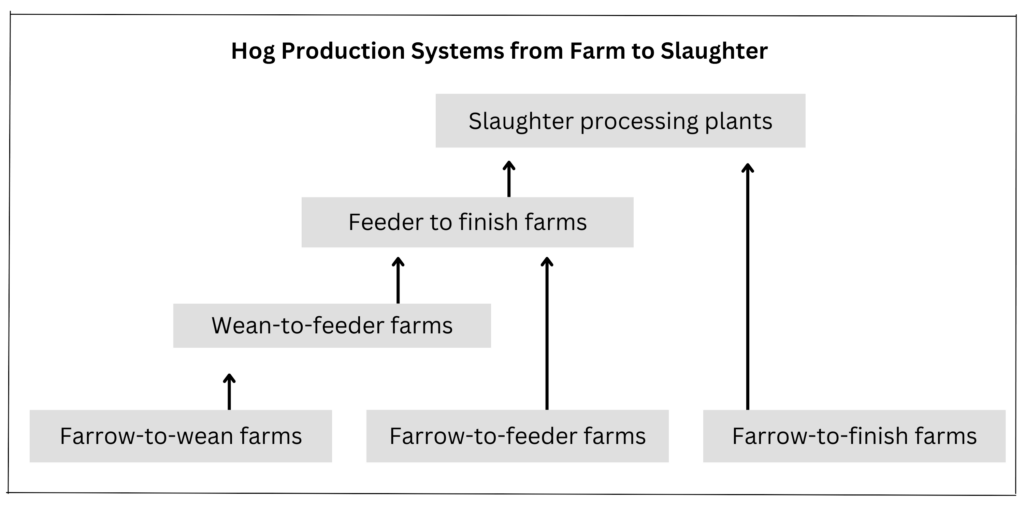1. A typical pig farm sells ~54,000 pigs in a year, maintaining an inventory of ~32,000 pigs.
2. A typical pig finishing house or shed is about 20,000 square feet, generally holding 1,000- 2,500 pigs per shed or house.
3. A common size pen is about 190 square feet (the size of a small to medium bedroom) each holding ~25 pigs.
4. Breeding operations range in size; units with more than 5,000 sows are common.
A typical pig farm sells ~54,000 pigs in a year. That is considered the midpoint – meaning that half of all pigs are on farms selling at least that many, and half are from farms selling less.[1]
Referring to the average number of pigs sold by a farm (rather than typical) would present a misleading picture. Farms with sales of more than 2,000 pigs make up ~19% of all pig farms, but they generate almost 99% of all pig sales.[2] Actual production is steeply tilted towards very large producers.
MacDonald, J.M. (2020). Tracking the Consolidation of U.S. Agriculture. Applied Economic Perspectives and Policy, 42(3), 361–379, Table 3, p. 370. [Based on “author’s calculations” and “confidential records” from the 2017 Census of Ag, MacDonald estimates this figure at 51,300. The 2022 Census of Ag shows an increase of ~5% in the average pig sales per farm for those farms that sell >5,000 pigs per year (making up ~94% of total sales.) Applying a 5% increase to 51,300 gives ~53,900. Since we do not have any info on the distribution of the increase within that largest category of farms, this 5% increase (from 51,300 to ~54,000) is our best estimate.]
USDA (2024) 2022 Census of Agriculture, Summary and State Data, AC-17-A-51, Table 22. [number of pigs sold on farms with >2000 divided by total number of pigs sold on all farms: 237,099,307/ 240,064,008 = 98.76%] [Note: according to the USDA and the industry, animals raised for meat who are under 120 pounds are called pigs, and over 120 pounds are hogs. We often use the term pigs for both.]
The typical inventory is ~32,000 pigs on a factory farm. This is based on a yearly sales midpoint of 54,000 pigs and a total herd inventory estimated at ~60% of the yearly slaughter.[1-3]
MacDonald, J.M. (2020). Tracking the Consolidation of U.S. Agriculture. Applied Economic Perspectives and Policy, 42(3), 361–379, table 3, p. 370. [Report notes 51,300 mid-point for 2017, extrapolated to 54,000 for 2022, per previous Q&A]
Total pigs slaughtered = 125,400,200 [UDSA Livestock Slaughter 2022 Summary, ISSN: 0499-0544, p. 8]. Total pigs in inventory = 73,392,999 [USDA 2022 Census of Agriculture, Summary and State Data, AC-17-A-51, Table 22]
Analysis: a) Pig inventory (73,392,999) divide by Pig slaughter (125,400,200) = 58.5%; b) Typical yearly sales = 54,000 x .585 = 31,590. This estimate assumes that a 59% inventory-to-slaughter ratio is more-or-less reflected in the typical inventory across a wide range of pig operations. The estimate does not appear to conflict with the fact that birth to slaughter for a finished hog takes about 6 months,[4,5] if we add an approximate 8% to 10% post-weaning death rate, the cleanup time on factory farms between herd placements, and the fact that breeding sows live for ~2 years.[6]
Davis, C.G., et al., (2022). U.S. hog production : rising output and changing trends in productivity growth. Economic Research Service, U.S. Department of Agriculture, p. 2.
The National Pork Board, Life Cycle of a Market Pig. https://porkcheckoff.org/pork-branding/facts-statistics/life-cycle-of-a-market-pig/
USDA APHIS (2024) Swine 2021 Part I: Reference of Management Practices on Large-Enterprise Swine Operations in the U.S. [See, Individual Tables, Table B.6.a: Notes that “large operations” with >500 sows averaged 2.8 parities at culling or death, with smaller operations much higher and average of all sites at 3.0. For 3 parities, average life span is likely slightly under 2 years.]
A typical pig finishing house or shed is about 100 x 200 feet – or about 20,000 square feet.[1] Large sheds can be about 35,000 square feet.[2]
A “finishing” farm is one that houses pigs up until their slaughter weight. Pigs can be sent to finishing farms at different ages depending on the type of operation.
National Hog Farmer (2011). Designing ‘greener’ pig barns: Advisory group rethinks typical finishing barn design options. https://www.nationalhogfarmer.com/facilities-equipment/designing-greener-pig-barns-0919
Tom Bechman (2018) See inside brand-new confinement hog barn. Farm Progress. https://www.farmprogress.com/hog/see-inside-brand-new-confinement-hog-barn
Pig finishing operations typically have between 1,000 and 2,500 pigs per shed or house. A common size is ~2,500 pigs.[1-3] A large shed can hold ~4,400 pigs.[4]
National Hog Farmer (2011). Designing ‘greener’ pig barns: Advisory group rethinks typical finishing barn design options.
Betsy Freese (2018). Want to Contract Feed Pigs? Here’s What You Need to Know, Successful Farming. https://www.agriculture.com/livestock/hogs/want-to-contract-feed-pigs-heres-what-you-need-to-know
Michael Brumm, Univ. of Nebraska (2019). Space Allocation Decision for Nursery and Grow-Finish Facilities, U.S. Pork Center of Excellence/Cooperative Extension, table 2. https://swine.extension.org/space-allocation-decisions-for-nursery-and-grow-finish-facilities/
Tom Bechman (2018) See inside brand-new confinement hog barn. Farm Progress.
A common size for a factory farm pig pen is 10’ by 19’ or 190 square feet. There are generally around 25 pigs raised in this size pen.[1] A small garage is ~240 square feet.
Larger and smaller pen configurations and numbers of pigs are common. Pens can have between 16 to 100 pigs, with 30 to 50 pigs per pen also being common set-ups.[2,3]
Each pig in a finishing operation is allocated average floor space of about 7.2 to 8.0 square feet.[4-7] Eight square feet is about 14” wide by 7’ long, or about half the size of a typical human casket. The average slaughter weight of pigs is 287 pounds.[8]
Michael Brumm, Univ. of Nebraska (2019). Space Allocation Decision for Nursery and Grow-Finish Facilities, U.S. Pork Center of Excellence/Cooperative Extension, table 2. [190 sq. ft. per 25 pigs = 7.6 square feet per pig, a common space allocation]
National Hog Farmer (2011). Designing ‘greener’ pig barns: Advisory group rethinks typical finishing barn design options.
USDA Animal and Plant Health Inspection Service (2011) Swine Industry Manual, Foreign Animal Disease Preparedness & Response Plan (FAD PReP), p. 13.
National Pork Board (2018) Swine Care Handbook, Pork Checkoff, p. 15.
Michael Brumm (2019) Space Allocation Decision for Nursery and Grow-Finish Facilities.
Designing ‘greener’ pig barns: Advisory group rethinks typical finishing barn design options.
Buhr, B. et al., (2010). Economic Impacts of Increasing finishing Pig Space Allocation, Pork Information Gateway. https://porkgateway.org/resource/economic-impacts-of-increasing-finishing-pig-space- allocation/ )
USDA NASS (2024) Livestock Slaughter 2023 Summary, ISSN: 0499-0544, p.15. [average hog live weight at slaughter = 287 pounds in 2023]
Pig farms are becoming more specialized, with many farms housing pigs raised for slaughter for specific periods of their 6-month life. There are generally three paths from birth to slaughter.[1]

The largest inventory of pigs, ~43%, are on “feeder to finish” operations (the final stage of pig production). About 28% are on “farrow to finish” (includes all stages of production).[2]
Sows raised for breeding are incorporated into farrow-to-wean, farrow-to-feeder and farrow-to-finish operations, typically living for about 2 years, shifting back and forth from gestation crates to farrowing crates.[3]
Davis, C.G., et al., (2022). U.S. hog production : rising output and changing trends in productivity growth. Economic Research Service, U.S. Department of Agriculture, p. 3.
USDA (2024) 2022 Census of Agriculture, Summary and State Data, AC-17-A-51, Table 25. [2022 pig inventory in finish only operations = 31,985,403, or 43.3% of 73,817,751 (Table 22); inventory in farrow to finish = 20,898,972 , or 28.3%]
USDA APHIS (2024) Swine 2021 Part I: Reference of Management Practices on Large-Enterprise Swine Operations in the U.S. [See: Individual Tables, Table B.6.a: Notes that “large operations” with >500 sows averaged 2.8 parities at culling or death, with smaller operations much higher and average of all sites at 3.0. For 3 parities, average life span is likely slightly under 2 years.]
Factory farms specializing in pig reproduction range in size, with larger operations at 10,000 to 12,000 sows.[1-3] Units with more than 5,000 sows are common.[4,5]
The average U.S. inventory of breeding pigs was about 6 million in 2025, mostly sows and gilts with a small number of boars, likely less than 1% of total sows and gilts.[6-8]
Bradley Eckberg (August 28, 2024) U.S. sow farm production update. National Hog Farmer. https://www.nationalhogfarmer.com/livestock-management/u-s-sow-farm-production-update [“The average sow farm size was 2,583, with the smallest farm size of 500 females and the largest at 11,000 females.” This refers to a study of ~300 U.S. farms.]
Farm Journal’s Pork (January 26, 2023) First All-Steel Swine Barns Under Construction in South Dakota. https://www.porkbusiness.com/news/industry/first-all-steel-swine-barns-under-construction-south-dakota [“A new 12,000-sow complex is under construction in South Dakota that features the first prefabricated steel swine barns in the U.S.”]
Ross, J. W. (2019). Identification of putative factors contributing to pelvic organ prolapse in sows, Industry summary. Iowa State University, Table 1, p. 5. [Maximum sows on operation = 10,606. Average = 3,713. Study was of 104 farms from 15 U.S. states.]
Betsy Freese (April 17, 2017) New Sow Barns for Iowa Select Farms. Successful Farming. [“Three more sow farms are coming, all larger – at 7,500 sows – than this one.”]
Mindy Ward, Editor, Missouri Ruralist (June 8, 2017) Take a peek inside a 5,500-sow unit. National Hog Farmer. https://www.nationalhogfarmer.com/farming-business-management/take-a-peek-inside-a-5-500-sow-unit
USDA NASS (June 1, 2025) Quarterly Hogs and Pigs Inventory. [“Of the 75.1 million hogs and pigs, 69.2 million were market hogs, while 5.98 million were kept for breeding.”]
USDA NASS (2020) Hogs and Pigs: What is included in NASS Estimates. [“Kept for Breeding: A point in time estimate as of the reference date of the inventory of boars, sows, and gilts which have the primary function of producing more swine.” This is “a point in time estimate as of the reference date of swine inventory.”]
Bradley Eckberg (August 28, 2024) U.S. sow farm production update. [“By the millennium, AI (artificial insemination) was used on more than 99% of all sows inseminated, over 35,000 boars were housed in 200+ studs in the US. The days of having 400,000 natural service boars on farm were over.”]
